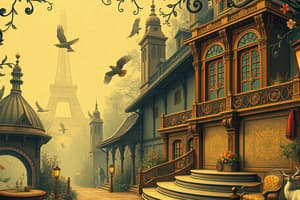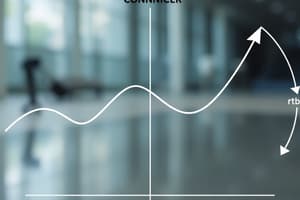Podcast
Questions and Answers
How does the economy typically behave during the trough phase of the business cycle?
How does the economy typically behave during the trough phase of the business cycle?
Unemployment rises, but the overall economic trend improves.
Explain how central banks can influence the business cycle through monetary policy.
Explain how central banks can influence the business cycle through monetary policy.
Central banks can influence the business cycle by controlling interest rates. Raising interest rates can reduce borrowing costs and encourage investment, while lowering interest rates can stimulate demand and promote inflation.
How can fiscal policy impact the business cycle?
How can fiscal policy impact the business cycle?
Government policies on taxation, public expenditures, and inflation can affect the business cycle. Increased government spending during a recession can help boost economic activity.
In what way can technological changes affect the business cycle?
In what way can technological changes affect the business cycle?
How do external shocks like wars or natural disasters impact the business cycle?
How do external shocks like wars or natural disasters impact the business cycle?
Flashcards are hidden until you start studying
Study Notes
Business Cycle
The business cycle is the fluctuation of economic activity over time, including changes in employment, production, trade, and investment. It consists of alternating periods of expansion (growth) and contraction (recession), also known as booms and busts. This pattern has been observed in many countries around the world.
Phases of the Business Cycle
There are typically four primary stages in the business cycle:
Expansion (Boom) Phase
This phase begins with an uptick in economic growth after a recession has ended. During this period, businesses start to increase their production levels, leading to an increase in employment. As more people have jobs and wages rise, consumer spending increases. Inflation can begin to accelerate during this stage, which may lead central banks to tighten monetary policy to slow down inflation.
Peak Phase
In the peak phase, the economy reaches its highest level of activity before entering into a contractionary phase. At this point, unemployment is low, production capacity is fully utilized, and prices for goods and services reach their maximum.
Contraction (Bust) Phase
As the name suggests, this phase represents a decline in economic growth. Factors such as rising interest rates, higher taxes, and declining consumer confidence can cause businesses to decrease their investment and spending activities, ultimately resulting in job losses, reduced income, and lower consumption levels.
Trough Phase
After the contraction phase, the economy starts to recover, indicating the beginning of a new expansion phase. Unemployment rises, but the overall economic trend improves.
Factors Affecting Business Cycles
The business cycle is influenced by a variety of factors, both internal and external to the economy. Some of these factors include:
-
Monetary Policy: Central banks can influence the business cycle through their control over interest rates. By raising interest rates, they can reduce borrowing costs and encourage consumers to invest, thereby boosting economic growth. On the other hand, lower interest rates can stimulate demand and promote inflation.
-
Fiscal Policy: Government policies on taxation, public expenditures, and inflation can affect the business cycle. For instance, increased government spending during a recession can help boost economic activity. However, it depends on whether the funds are used efficiently and effectively.
-
Technological Changes: Technological advancements can impact the business cycle by changing the cost structure of various industries, making some goods cheaper and others more expensive. They can also alter consumer preferences, influencing the types of products produced and consumed.
-
External Shocks: External shocks, like wars or natural disasters, can disrupt global supply chains and adversely affect economies worldwide. These events may cause temporary contractions in economic activity, followed by recovery once conditions normalize.
Understanding these factors can help policymakers take appropriate measures to mitigate the negative effects of the business cycle and maintain stable economic growth.
Studying That Suits You
Use AI to generate personalized quizzes and flashcards to suit your learning preferences.




